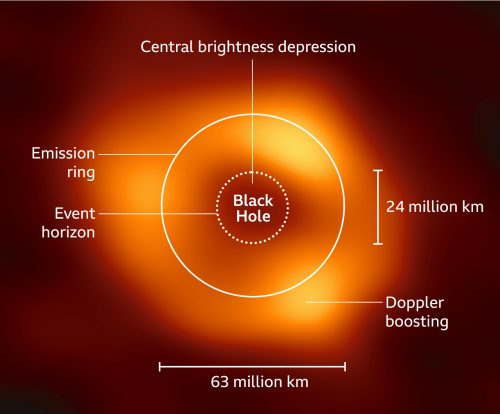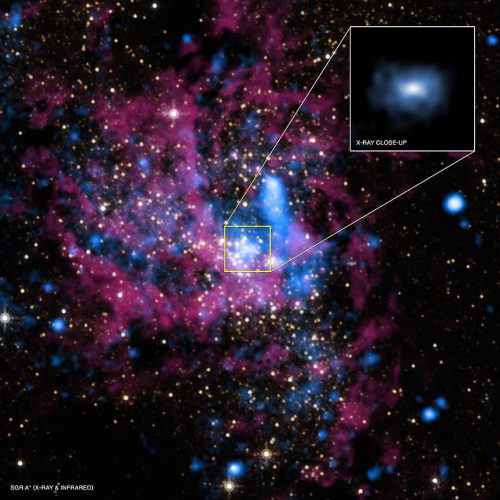May 7 to 22 is Science Odyssey, a celebration of all things science! OWLconnected is recognizing this two-week event with lots of science content, as well as with an amazing contest, presented by our friends at the Natural Sciences and Engineering Research Council of Canada (NSERC). Details are at the end of this post—be sure to enter!
What a picture!
On Thursday morning, huge news broke in the world of astronomy.
Thanks to the astronomers working with the Event Horizon Telescope (EHT), we have a picture of Sagittarius A* (Sgr A*), the supermassive black hole at the centre of the Milky Way galaxy.
Our galaxy! Our black hole!
As only the second-ever image taken of a black hole, this type of picture is truly a rarity. And this picture was even harder to capture than the first! Before we get to why, let's take a moment to meet the heart of our galaxy.
The centre of it all

This image explains what you're seeing in this image of Sgr A*. (EHT Collaboration/BBC)
Sgr A* is a monstrous thing. Known as a supermassive black hole, it is four million times the mass of the Sun and about 60 million kilometres (40 million miles) across!
When you take that into account, it becomes easier to understand how its gravity is able to anchor something as large as the Milky Way. Our entire solar system is caught under its spell.
We know you're there ... somewhere
But just because something is large, doesn't mean that it's easy to see. This has always been the trick with black holes. Since their immense gravity stops anything from escaping—even light—we can't actually see them.
This is why that first-ever image of a black hole (M87* in 2019) was such a massive deal. Before then, astronomers only theorized (estimated) that black holes existed. Something had to be there exerting all of that powerful gravity on surrounding objects. But taking a photo of something that you can't see is, well, difficult!
Even harder than before

This 2013 image of the area around Sgr A* was taken by NASA Chandra X-ray Observatory. It shows how the black hole had always previously been hidden by a cloud of glowing gas. (NASA)
The lessons learned in capturing M87* helped here. Instead of focusing on the black hole itself, astronomers must focus on the 'shadow' that it leaves on the glowing cloud of gas that is rapidly orbiting the black hole. But even that is far from easy.
Because while the gas—called the emission ring—does in fact glow, it is also moving super fast around the black hole. So how do you get a picture of something that is completely surrounded by gas moving at almost the speed of light? Very, very carefully!
Chi-kwan (‘CK’) Chan, one of the key astronomers on the project, explains:
"The gas in the vicinity of the black holes moves at the same speed—nearly as fast as light—around both Sgr A* and M87*. But where gas takes days to weeks to orbit the larger M87*, in the much smaller Sgr A* it completes an orbit in mere minutes. This means the brightness and pattern of the gas around Sgr A* was changing rapidly as the EHT Collaboration was observing it—a bit like trying to take a clear picture of a puppy quickly chasing its tail.”
Caught the puppy
The Atacama Large Millimetre Array (ALMA) in Chile is one of the eight telescopes around the world that make up the Event Horizon Telescope. (EHT Collaboration/BBC)
We love that idea. (Sit still for the photo, puppy!) Thanks to the EHT's eight telescopes around the world, many nights of observations, and countless hours of working with the data it collected, we finally have proof that our galaxy is anchored by a black hole.
This is more than just exciting in terms of our own galaxy, too. Scientists are convinced that all galaxies have a supermassive black hole at their centre. In many cases, they are billions of times larger than Sgr A*! By learning about this one, we're learning a little something about them all!
Contest alert
Don't forget to enter the Science Odyssey Contest! CLICK HERE TO ENTER.

 Sagittarius A* may be 26,000 light years from Earth, but it affects us in a big way. (EHT Collaboration)
Sagittarius A* may be 26,000 light years from Earth, but it affects us in a big way. (EHT Collaboration)









